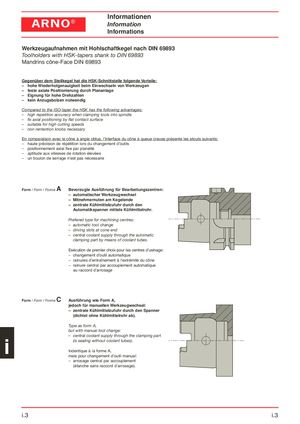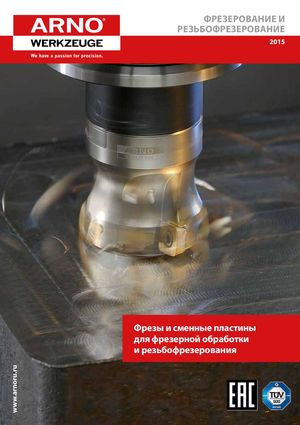Каталог ARNO оснастка для токарного и фрезерного оборудования - страница 110
Навигация

Informationen ARNO® Information Informations Werkzeugaufnahmen mit Hohlschaftkegel nach DIN 69893 Toolholders with HSK-tapers shank to DIN 69893 Mandrins cône-Face DIN 69893 Gegenüber dem Steilkegel hat die HSK-Schnittstelle folgende Vorteile: – hohe Wiederholgenauigkeit beim Einwechseln von Werkzeugen – feste axiale Positionierung durch Plananlage – Eignung für hohe Drehzahlen – kein Anzugsbolzen notwendig Compared to the ISO-taper the HSK has the following advantages: – high repetition accuracy when clamping tools into spindle – fix axial positioning by flat contact surface – suitable for high cutting speeds – non rentention knobs necessary En comparaison avec le cône à angle obtus, l’interface du cône à queue creuse présente les atouts suivants: – haute précision de répétition lors du changement d’outils – positionnement axial fixe par planéité – aptitude aux vitesses de rotation élevées – un boulon de serrage n’est pas nécessaire Form / Form / Forme A Bevorzugte Ausführung für Bearbeitungszentren: – automatischer Werkzeugwechsel – Mitnehmernuten am Kegelende – zentrale Kühlmittelzufuhr durch den Automatikspanner mittels Kühlmittelrohr. Prefered type for machining centres: – automatic tool change – driving slots at cone end – central coolant supply through the automatic clamping part by means of coolant tubes. Exécution de premier choix pour les centres d’usinage: – changement d’outil automatique – rainures d’entraînement à l’extrémité du cône – rainure central par accouplement automatique au raccord d’arrosage Form / Form / Forme C Ausführung wie Form A, jedoch für manuellen Werkzeugwechsel: – zentrale Kühlmittelzufuhr durch den Spanner (dichtet ohne Kühlmittelrohr ab). Type as form A, but with manual tool change: – central coolant supply through the clamping part i (is sealing without coolant tubes).Indentique à la forme A, mais pour changement d’outil manual: – arrosage central par accouplement (étanche sans raccord d’arrosage). i.3 i.3
 Каталог ARNO фрезы и сменные пластины для фрезерной обработки 2015
Каталог ARNO фрезы и сменные пластины для фрезерной обработки 2015 Каталог ARNO монолитный осевой инструмент
Каталог ARNO монолитный осевой инструмент Каталог ARNO концевые твердосплавные фрезы AFV
Каталог ARNO концевые твердосплавные фрезы AFV Каталог ARNO оснастка для автоматов продольного точения
Каталог ARNO оснастка для автоматов продольного точения Каталог ARNO тиски станочные
Каталог ARNO тиски станочные Каталог ARNO пластины CBN для токарной обработки
Каталог ARNO пластины CBN для токарной обработки